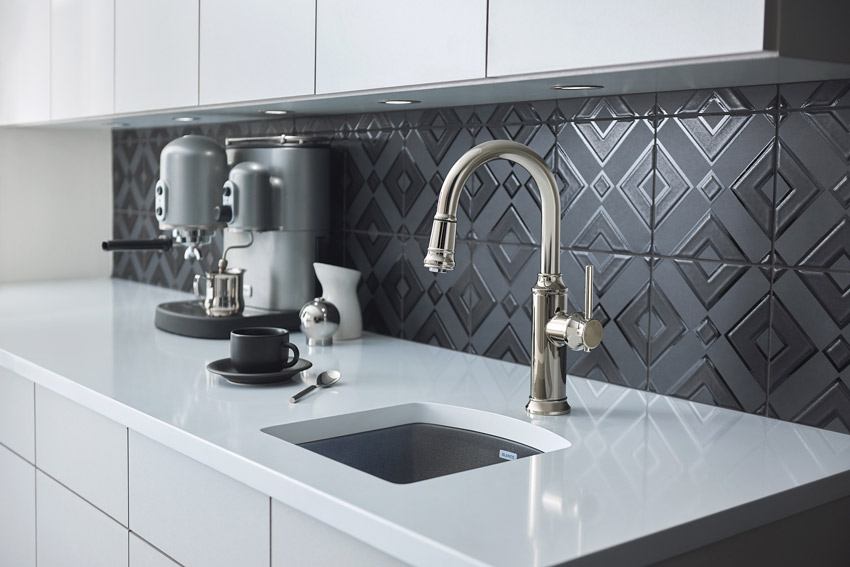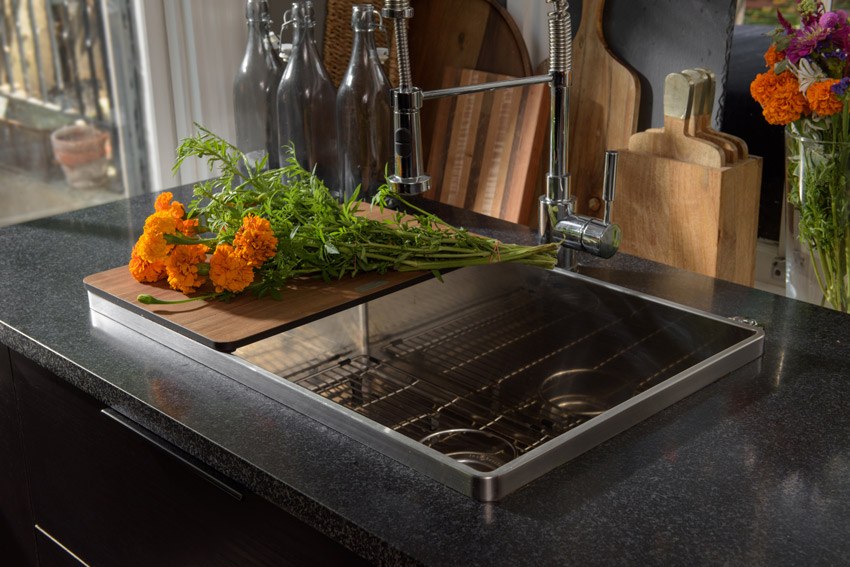Mastering the Art of the Kitchen Sink
Rising Trends in the Art
Colors and styles are all trending toward a contemporary aesthetic in today’s kitchen. Additionally, a transitional style in kitchens is emerging, blending both contemporary and traditional furniture and finishes into the design. Countertops and LED lighting are dominant product features; quartz is the most predominant material being used in kitchen countertops.
Sinks and faucets are also trending in the direction of transitional and modern looks. Smart, neutral colors, organic shapes, and clean lines are all taking hold. Peering into the future, designers and architects surveyed by a leading manufacturer responded that simpler designs and styles may be what’s next in the future of kitchen design. These simplified designs will favor fewer details and clean lines.
The living kitchen is driving many of these aesthetic trends as consumers are blending kitchen and furnished home areas into great rooms.
Color
When it comes to choosing a color for the kitchen, neutrals tend to win every time. With the average kitchen only remodeled every 15 years, highly stylized products and choices are eschewed to avoid dating the kitchen design. Greys and whites remain the most popular colors, and are projected to remain trending in kitchen designs for the future. However, some blues and soft pastels are appearing in palettes along the West Coast, particularly in California. Browns and creams also remain popular. The use of small areas of color as an accent within kitchen design is growing, and, once again, ties into the trend of personalizing a space. This aesthetic can range from using color on accent tiles to cabinets and even faucets.
Stainless steel remains a popular and in-demand product. However, designers are seeing an uptick in demand for neutral colors, like dual finishes for faucets and color-composite sinks. Stainless or satin nickel and polished chrome continue to be strong for faucets and hardware, especially for contemporary kitchens.
As composite materials for the kitchen escalate in popularity, consumers and designers will need to familiarize themselves with the marketplace and manufacturers’ proprietary blends. Not all materials are equal in touch or in durability, and not every material is nonporous and resistant to bacteria.
Technology
As smart technology continues its ascension in the home, so too will technology in kitchens continue to advance. While technology is not typically a term associated sinks and faucets, it highlights the groundbreaking ideas flourishing among manufacturers. More accessories are finding their way into the sink marketplace, adding functionality and saving space. Multifunctioning accessories such as built-in cutting boards and colanders can save space; a huge concern for homeowners. Today’s sinks may come with built-in cutting boards, colanders, and magnetic caddies for cleaning tools. They come in compact sizes and are custom fit to maximize sink use. Basin grids supplied by sink manufacturers help to maintain the bottom of the sink and keep dishes and other items from damaging the surface.
“What you are seeing in the market is a result of better production and product development technologies, which shortens the cycle of innovation,” explains BLANCO Product Manager Eric Gundersen. Technology is always improving, and the designs mature with it.
Materials
While stainless steel has had a long reign as the most popular material for kitchen sinks, a new survey of architects and designers reveals that stainless steel and granite composite are now head-to-head in popularity. As composite sinks that marry the benefits natural stone and durability have emerged, it has prompted manufacturers to introduce new stainless steel materials that are stronger, extremely resistant to scratches, and impervious to fingerprints.

Recently, sinks sizes are trending away from standard options to embrace both smaller and larger profiles.
Sink Size and Design
Overall, sink size today shows a growing trend away from the limitations of standardized sink sizes, with designers and architects embracing both larger sizes and smaller, multiple sinks in a home. With the 2008 recession, many manufacturers’ lines compressed to the most popular SKUs for sizes. The market is now seeing growth both for smaller and larger sinks as new housing and remodeling rebound.
Single bowls continue to trend. Out of sink-bowl designs, single-bowl sinks are at 45 percent and are more popular than a double-bowl or a one-and-three-quarter bowl design. Single-basin sinks reflect an overall aesthetic trend toward simplification of lines, which also is mirrored by the popularity of undermount and flush-mount installations.
For sinks, apron-front, tight-radius, and rectangular single bowls are all trending right now. The general look is decidedly more design centric and modern—but also with a comfort or transitional feel. Not every sink or faucet is modern to the point of minimalist design. Rather, it is a general aesthetic edit that has gone through every collection, bringing with it cleaner lines, improved functionality, and enhanced performance, hygiene, and durability.

At the Miller Residence, built-in accessories help to maximize every inch of usable space in the sink and the kitchen itself.
The Challenge and Potential for the Art of the Sink
Today’s kitchen is not only the center for family, food, and entertainment, but it also is required to be stylish, aesthetically pleasing, functional, durable, and hygienic. Furthermore, it has to satisfy the needs of all its users and support a home’s overall design. Open floorplan schemes are at an all-time high, making living kitchens more prevalent in design room settings. The living kitchen is driving the shift toward contemporary, neutral, and organic lines, as consumers are blending kitchen and furnished home areas into great rooms. Homeowners with limited space want kitchens—and kitchen sinks—that look good and match the rest of the home’s aesthetic. The right combination of sink and faucet creates an ambience that matches any home living style.
Stylized mudrooms and laundry rooms also are bringing design out of the kitchen and into other areas of the home.
The designer helps to define what is important to their client in a kitchen. What can stay and what can go? By taking a lifestyle approach to a design project, the professional creates a space and selects products suitable for how clients cook, entertain, and live every day.
Paying attention to the unique combination of space, users will guide the selection of the best size, material, and style of kitchen sink. Ultimately, “things that are designed to be used always have an innate beauty.” —Julia Child
Amanda Voss, MPP, is an author, editor, and policy analyst writing for multiple publications. She also serves as the managing editor for Energy Design Update.

|
BLANCO has passionately elevated the standards for luxury sinks, faucets, and decorative accessories. Proud of its European heritage and award-winning German engineering, BLANCO has been committed to innovative design and unsurpassed service since 1925. Dedicated to uncompromising quality, every sink is closely inspected many times before it receives the BLANCO name. www.blancoamerica.com |








